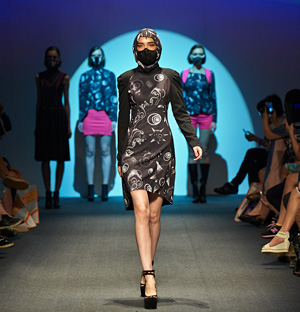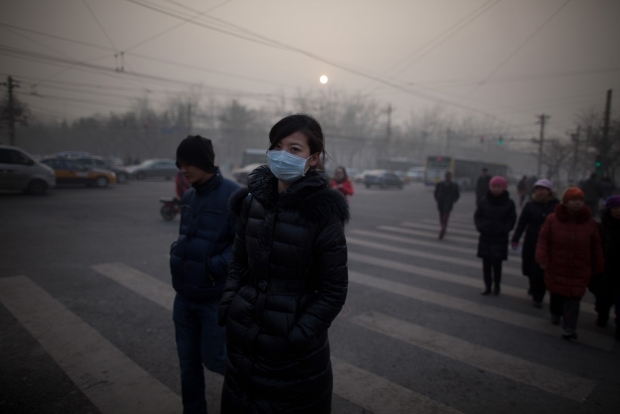“Mommy, why don’t I wear a face mask?” asked my nine-year-old daughter Maggie nearly every day during the first few weeks of school. Two of her expat classmates had been in Beijing less than a year, but it seemed as if they wore theirs all the time. “Don’t your parents worry about air pollution?” they’d ask Maggie. “Don’t they care about you?”
As longtime residents of Beijing my husband and I, both Americans, take air pollution seriously. Since we arrived nearly seven years ago, we have kept our Swedish air purifiers on around the clock at home and we are scrupulous about scheduled filter changes. We send Maggie to an international school where an athletic dome shields playing students from the smog in a pressurized bubble of pumped-in filtered air.
So, yes, we are serious, but like many longtime residents of China, we drew the line at face masks. We were fine in our own home. We figured that once we stepped outside, we couldn’t really control the environment, so better to not even bother trying. What good was a face mask against an all-encompassing airpocalypse?
This attitude is similar to that of older Beijingers. They know the dirty air is not healthy for humans, but they don’t think there is anything anyone can do about it. Wang Jinling is a case in point. The 59-year-old is not swayed by the small, but growing, number of people he sees wearing face masks these days. He thinks they are wasting their money.
“I don’t use a mask because I don’t think it’s much use,” he said.
Wang rides his motorcycle to and from work each day, for about a half hour each way. He accepts the fact that a helmet could save his life if he has an accident, but even though air pollution also threatens his well-being he refuses to wear a face mask.
“When I ride my motorcycle, I wear my helmet, which has a visor that I pull down over my entire face,” he said. “That’s enough protection. I don’t need to wear a mask too.”
Their elders may seem blasé, but younger Chinese are pragmatic in the modern sense. They understand that they need to protect themselves against Beijing’s often hazardously high, and sometimes even astonishingly toxic, levels of air pollution. The government has vowed to deal with the problem, but since it’s not going to be resolved anytime soon masks are here to stay.
Zhang Qian is a 27-year-old Beijing resident who started wearing a mask regularly after a health checkup last year.
“The doctor told me my throat’s inflamed. He said that most people who live in Beijing more or less have throat problems, problems with breathing, caused by the environment,” she said.
Zhang used to decide how bad the air was by checking an app that pushed the latest Air Quality Index (AQI) readings to her smart phone, but she deleted it because it was too depressing. Now, she just looks out her window every morning. If she can’t see the building 200 meters away, she knows it’s mask time.
Zhang’s preferred mask is from 3M, the Minnesota company better known for creating the sticky Post-It note. A disposable 3M face mask with an exhalation valve costs roughly $3.50 and can be found in international health clinics and supermarkets around town. They are utilitarian and only come in one color: white. Zhang doesn’t mind that the masks won’t win any beauty contests. They need to be replaced within a few days anyhow, or—depending on the severity of the capital’s pollution—sometimes after just a few hours, if they have turned gray from soot. But Zhang knows other young people her age would spend a little bit more to buy something prettier. “If they have enough money, then there is a market for good-looking masks,” she said.

This is where Vogmask comes in. The California company is positioning itself as the stylish option. Though customers pay 10 times the cost of a 3M mask for a hip alternative, Vogmask justifies its higher price tags with funky design and a much longer lifespan.
China’s ongoing pollution woes have driven up sales for both companies, and their prospects for continued growth look as rosy as the skies are grey. 3M masks were sold out in China last year because of record levels of air pollution. The company predicts China’s share of its global sales will expand, from about 10 percent last year to about 15 percent over the next five years. Meanwhile, in a little more than one year of operating in China, Vogmask sales have tripled.
Face masks are inherently unattractive, but Vogmask is marketing them as an appealing accessory. The company made news during Hong Kong Fashion Week in July by sponsoring a runway show for clothing designs that incorporated its masks. Participating was first-time designer Nina Griffee. “If we’re going to wear them, they may as well look nice,” said the 27-year-old Brit who lived in Beijing for five years and now splits her time between the Chinese capital and less-polluted Hong Kong.
Plastered T-shirts is a Beijing company that has adapted some of its t-shirt designs for Vogmasks. Ironically, the company’s founder, British entrepreneur and longtime Beijing resident Dominic Johnson-Hill, isn’t happy with his newest line: “They fog up my sunglasses,” he said.
Although Johnson-Hill admits taking pleasure from glimpsing Plastered face mask designs worn on the street—the panda with a gun motif or the group of cherubic school girls, for instance—he’s crossing his fingers that they won’t last.
“It’s not really a fashion icon yet, the face mask,” he said. “We’re all hoping that it’s going to be temporary, that we’re not going to need them in years to come because [air pollution is] something we would like to be rid of.” Then, with gallows humor, he added: “I think maybe I should be wishing for global warming, so I can sell more t-shirts.”
After denying for over six years that breathing the Beijing air was that bad, we’ve finally decided to “mask up.” I recently bought Maggie her first. I couldn’t find any child-sized 3Ms, so I ended up letting her pick one she would be more likely to wear. What did she choose? A colorful child-sized Vogmask, of course: a pretty Plastered design of bright red roses on a light green background. Since we’ve decided to continue our lives in so horribly polluted a city, I reasoned in the end that face masks are like seat belts or bike helmets—they’re annoying, but they improve a wearer’s chances of survival in the face of calamity.




